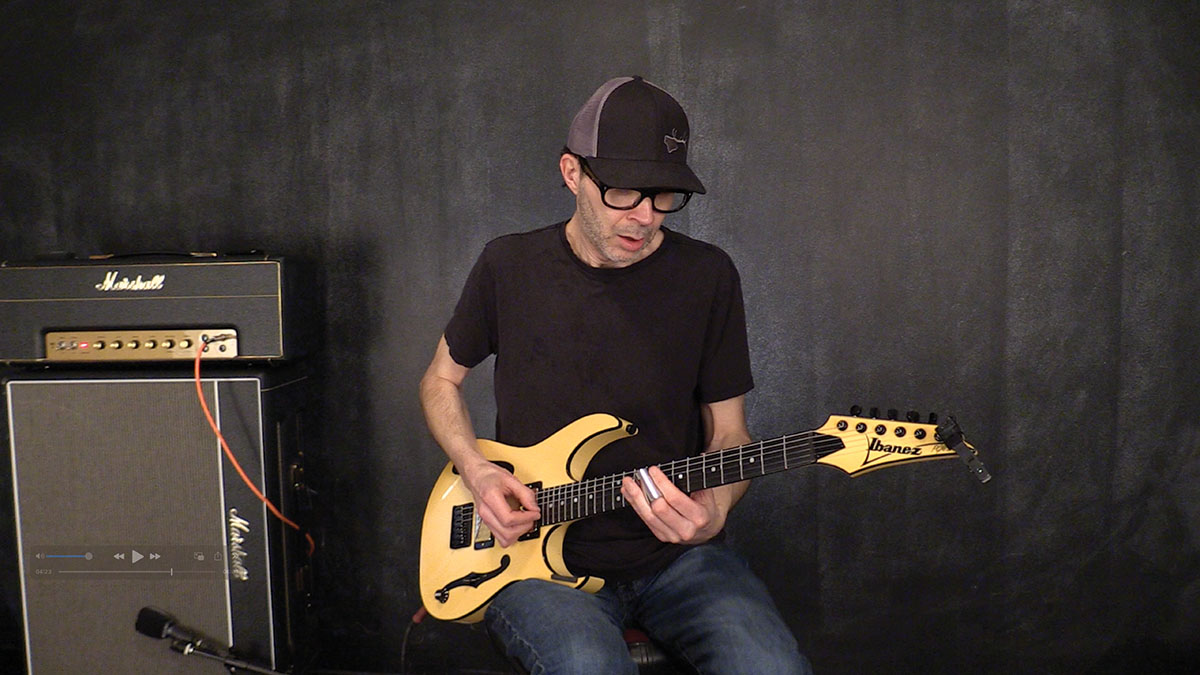“Typical scale practice is downright damaging for expressive playing… That’s not how singers sing”: Paul Gilbert shows you how to make your guitar solos more vocal and expressive
In this exclusive video lesson, the legendary virtuoso treats you to a masterclass on transferring vocal phrases to the guitar

GUITAR SHOWCASE 2023: Paul Gilbert exploded onto the 1980s rock scene with his exciting brand of speedy and highly technical soloing. He has been part of two great rock bands, Mr. Big (soon set to embark on their final tour) and Racer X, but has also maintained a fabulous solo career.
In this article, Paul sets out to explain the goal of the lesson, which is to adapt vocal phrases for use on the electric guitar, in order to play with expression. We have notated the seven live performances so you can study the fingerings and try these ideas out yourself.
A strong melody is of course the obvious starting point and provides a launch pad for other lead phrases and soloing variations. Paul encourages you to test out melodies by singing them.
He stresses there are many great phrases that aren’t singable, too, but for this feature, it’s all about the vocal phrasing. As Paul performs the melody he taps his foot to create a strong relationship with the pulse.
The scale of choice for the first example is E Mixolydian (E-F#-G#-A-B-C#-D), which sounds great over an E7 chord. To get the Mixolydian sound in your head, Paul says he thinks of it more as the E minor pentatonic with a raised 3rd. Indeed, minor 3rd notes (G) can be bent slightly sharp within a Mixolydian framework.
Paul adds expression to the melody with the inclusion of long and short notes. This provides contrast and breathes life into the phrases. He chooses the long and short notes on the fly, simply calling it a ‘feel thing’.
Once the pitches, rhythm and duration of each note is decided, it’s time to add a variety of articulations including string bends, finger vibrato, finger slides and raking of the pick (fake sweeps), which adds attack to the notes. All of this articulation is necessary to provide the kind of emotion and feel that Paul wants us to inject into the solos.
The bottleneck slide is also a great tool for injecting a more vocal-like quality, so Paul uses the slide to swoop in and out of notes, and in this first example it’s easy to compare the sound of playing the melody with standard fretting and then with the slide.
Another key concept that Paul employs is taking the melody up an octave. This increases the excitement and gets double the mileage out of a single idea. Moving the melody up an octave can take some planning, so it’s vital to ensure that the fingering for the low version is playable on the high end’s much smaller frets.
As the video lesson progresses, Paul moves through different keys and time feels. A minor, C minor, D major, A major and E major are all explored to great effect. Each time, Paul checks the phrases to see if they are singable.
This melodic vocalising is a great thing to practise when creating your own phrases. The process also makes it less tempting for extended and constant fast widdling, which can numb listeners and prove difficult to relate to.
Take a close look at the way Paul fingers and picks his phrases. For your benefit, our notation contains all articulations and fretboard positions from his performances.
Hopefully there will be a new technique, lick or phrase here that inspires you. If you find one you like, then memorise it and tweak it to your liking. Once you have mastered some of the concepts in Paul’s vocal style examples, aim to create singable melodies of your own. Above all, be expressive!
Technique focus: Using the slide
Paul uses his slide quite a bit to perform the examples, so here are a few tips that may help you to develop a consistent tone and technique. You can experiment with different slide designs until you find one that is comfortable to use and has the right tone for you. Guitar slides come in all shapes and sizes, and some of the most popular types are made from chrome, steel, brass, glass, and ceramic.
The next step is to be mindful of the guitar setup; basically, the heavier the string gauge and the higher the action, the easier it is to use the slide. If you have a low action or light strings, the slide will work no problem, but there may be a danger of it rattling against the frets, finding that strings are buzzing, and notes not sounding as clear as they should. So spend time learning the correct pressure to get a good tone with your own guitar setup.
The next thing is string muting. The strings will ring both sides of the slide until you stop them. Many slide players place the slide on the fourth finger of the fretting hand, leaving the other fingers free to fret the odd note or to prevent ringing behind the slide.
You will need to mute the strings that you don’t play with the picking hand – lots of slide players use fingerstyle for this reason
Paul places the slide on his second finger, like Brett Garsed and Jeff Beck. It also allows the slide to be placed at a sharp angle to create a minor 3rd interval on the second and third strings.
You will need to mute the strings that you don’t play with the picking hand – lots of slide players use fingerstyle for this reason. The final thing to consider is intonation. Make sure the slide is directly above the fretwire. Moving from position to position quickly and in tune will require practice. Adding vibrato helps, too.
In addition to standard tuning, many slide players favour tunings like open G (D-G-D-G-B-D) and open D (D-A-D-F#-A-D).
Get the tone
Amp settings: Gain 8, Bass 6, Middle 7, Treble, 7, Reverb 3
For this recording, Paul used the bridge pickup of his Ibanez signature guitar plugged into a Marshall amplifier. Paul’s amp and pedals were set to provide a modern-sounding overdriven tone.
Any electric guitar will work well for this month’s performance. Just dial up a modern-sounding overdriven tone with plenty of sustain. And, of course, effects like reverb and echo (if used judiciously) can really help in creating a more expressive sound.
Example 1. Bluesy E7 phrasing (standard and slide)
To get the E7 Mixolydian ‘sound’, Paul thinks of it more as E minor pentatonic with a raised 3rd. He adds expression to the melody with long and short notes plus string bends, finger vibrato, finger slides and raking of the pick to add attack.
The slide is a great tool to create a more vocal-like quality. Paul uses it to swoop in and out of notes and in this first example it’s easy to compare the sound of playing with standard fretting and then playing with the slide.
Example 2. Phrasing In A minor
For this example, A natural minor (A-B-C-D-E-F-G) is the scale of choice. Again, the use of short and long notes is a key ingredient. Paul likes to use the first and second fingers of the fretting hand together, as “one big finger” for sliding in and out of the notes.
Example 3. Phrasing In C minor
The next example exploits the C natural minor scale (C-D-Eb-F-G-Ab-Bb) to create a rock-style melody. The finger vibrato here is wide and dramatic. Paul explains that the contrast between the long and short notes is one of the secrets to being expressive.
Example 4. Phrasing in D major
The next example uses the D major scale (D-E-F#-G-A-B-C#) to create a super-catchy phrase. A swung feel is employed here and Paul taps his foot on beats 2 and 4 to accentuate the accents.
The melody is played on one string and this demands the use of dramatic leaps and ear-grabbing finger slides. Paul checks the phrasing by singing the melody in retrospect and makes a few adjustments that you may wish to include.
Example 5. Phasing In A major
For this example, Paul uses string bending to create a strong vocal quality. When leaping up in pitch string muting can be an issue. Paul shares a muted rake technique where the strings are muted with the picking hand. The guitar pick is then raked into the target note. This provides attack and also cleans up the delivery.
Example 6. Phasing In E major (with slide)
Here, Paul uses some classic slide guitar vocabulary. The biggest challenge is to stop all the notes from ringing into each other. For this you may need to practise your picking-hand muting. Paul also suggests you try this phrase without the slide.
Example 7. Energised phrasing in E major (with slide)
This final example is a turbo-charged version of Ex 6. As this is played faster, the rhythmic phrasing changes to the three-note slide pattern starting on the downbeat each time. Paul explains that if the notes ring into each other it can create a more blues-orientated delivery.
Get The Pick Newsletter
All the latest guitar news, interviews, lessons, reviews, deals and more, direct to your inbox!
Jon Bishop is a UK-based guitarist and freelance musician, and a longtime contributor to Guitar Techniques and Total Guitar. He's a graduate of the Academy of Contemporary Music in Guildford and is touring and recording guitarist for British rock 'n' roll royalty Shakin’ Stevens.
“There are so many sounds to be discovered when you get away from using a pick”: Jared James Nichols shows you how to add “snap, crackle and pop” to your playing with banjo rolls and string snaps
Don't let chord inversions bamboozle you. It's simply the case of shuffling the notes around









![Joe Bonamassa [left] wears a deep blue suit and polka-dotted shirt and plays his green refin Strat; the late Irish blues legend Rory Gallagher [right] screams and inflicts some punishment on his heavily worn number one Stratocaster.](https://cdn.mos.cms.futurecdn.net/cw28h7UBcTVfTLs7p7eiLe.jpg)


